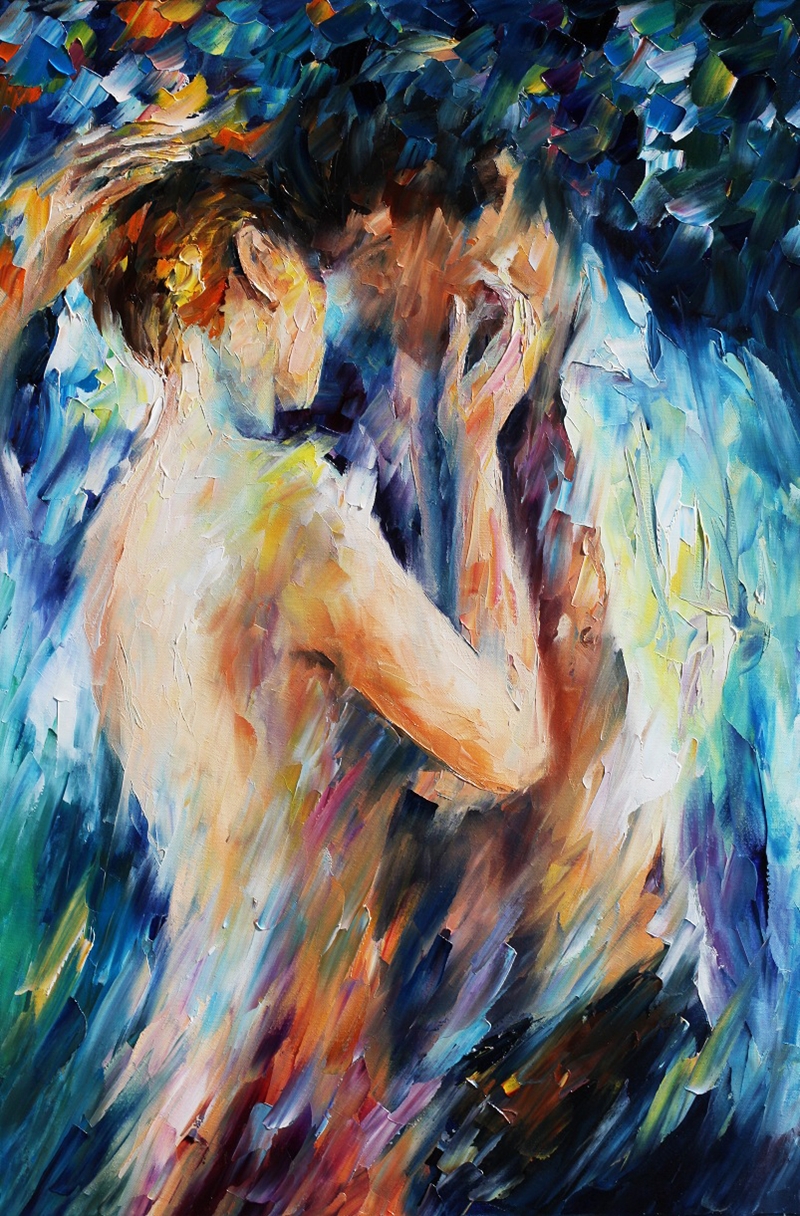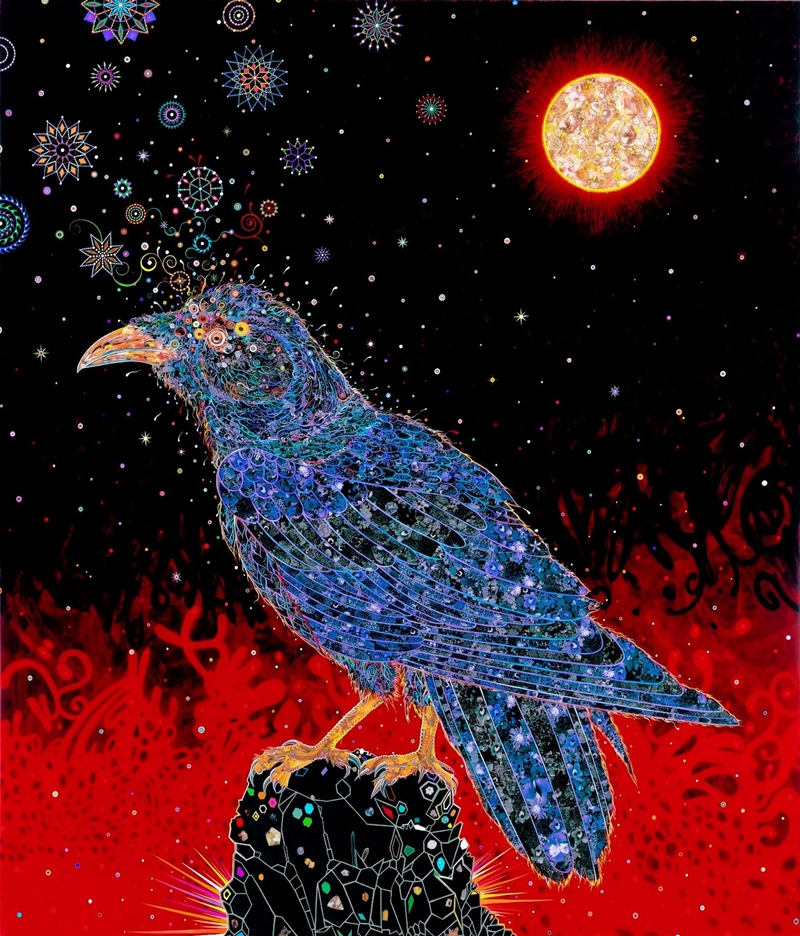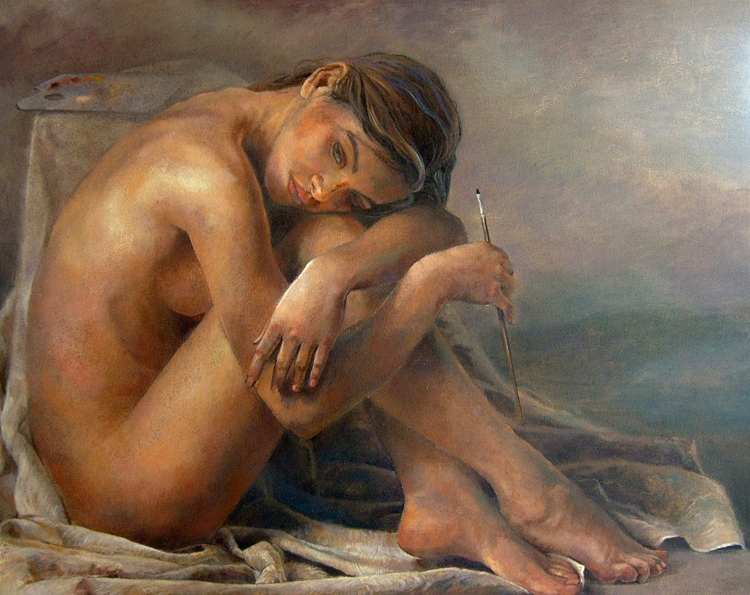Leonid Afremov 1955, is a Belarusian-Israeli modern impressionistic artist who works mainly with a palette knife and oils.More woks from Leonid Afremov ➥
↧
Leonid Afremov 1955 | The Impressionist Lovers
↧
Théo Van Rysselberghe
Théo van Rysselberghe [1862-1926] è stato un pittore Belga. Fu' uno dei maggiori rappresentanti del Puntinismo in Belgio.
Terminati gli studi all'Accademia di Belle arti di Gand e di Bruxelles sotto la direzione di Jean-François Portaels, Théo, nel 1881 partecipò per la prima volta ad una mostra al Salon di Bruxelles. Due anni dopo, assieme all'amico Octave Maus, fu uno dei fondatori del gruppo d'avanguardia "Les Vingt". Nel 1887 scoprì le opere di Georges Seurat e si appassionò alla tecnica divisionista, ma, alla fine del secolo, sostituì il puntinismo dei suoi quadri con delle composizioni a tocco più ampio, con larghe strisce allungate di colore. Come Seurat e Signac dipinse molti paesaggi marini e anche incisioni, sebbene queste ultime siano assai meno note.
Terminati gli studi all'Accademia di Belle arti di Gand e di Bruxelles sotto la direzione di Jean-François Portaels, Théo, nel 1881 partecipò per la prima volta ad una mostra al Salon di Bruxelles. Due anni dopo, assieme all'amico Octave Maus, fu uno dei fondatori del gruppo d'avanguardia "Les Vingt". Nel 1887 scoprì le opere di Georges Seurat e si appassionò alla tecnica divisionista, ma, alla fine del secolo, sostituì il puntinismo dei suoi quadri con delle composizioni a tocco più ampio, con larghe strisce allungate di colore. Come Seurat e Signac dipinse molti paesaggi marini e anche incisioni, sebbene queste ultime siano assai meno note.
↧
↧
Théo Van Rysselberghe | Belgian Pointillist painter
Théo (Théophile) van Rysselberghe [1862-1926] was a Belgian painter, who played a pivotal role in the European art scene at the turn of the century.
His famous portrait of Alice Sèthe, 1888 in blue and gold would become a turning point in his life. This time he used merely points in the portrait. She would later marry the sculptor Paul Dubois. Her sister, Maria Sèthe, also a model of van Rysselberghe, would marry the renowned Art Nouveau architect Henry Van de Velde. In that period he made many Neo-impressionistic portraits, such as the portrait of his wife Maria and their daughter Elisabeth. He had married Marie Monnom in 1889. They went on their honeymoon to the south of England and then to Brittany. This would also result in a number of Neo-impressionistic paintings. In Paris he had a meeting with Theo Van Gogh and managed thus to invite Vincent Van Gogh to the next exhibition in Brussels. That is where Van Gogh sold Vigne Rouge in Montmajour to Anna Boch, the only painting he ever sold.
His famous portrait of Alice Sèthe, 1888 in blue and gold would become a turning point in his life. This time he used merely points in the portrait. She would later marry the sculptor Paul Dubois. Her sister, Maria Sèthe, also a model of van Rysselberghe, would marry the renowned Art Nouveau architect Henry Van de Velde. In that period he made many Neo-impressionistic portraits, such as the portrait of his wife Maria and their daughter Elisabeth. He had married Marie Monnom in 1889. They went on their honeymoon to the south of England and then to Brittany. This would also result in a number of Neo-impressionistic paintings. In Paris he had a meeting with Theo Van Gogh and managed thus to invite Vincent Van Gogh to the next exhibition in Brussels. That is where Van Gogh sold Vigne Rouge in Montmajour to Anna Boch, the only painting he ever sold.
↧
Théo Van Rysselberghe | The Bather series
↧
Camille Pissarro | Autumn at Eragny
Camille Pissarro [1830-1903] was a Danish-French Impressionist and Neo-Impressionist painter. His importance resides in his contributions to both Impressionism and Post-Impressionism. Pissarro studied from great forerunners, including Gustave Courbet and Jean-Baptiste-Camille Corot. He later studied and worked alongside Georges Seurat and Paul Signac when he took on the Neo-Impressionist style at the age of 54.
↧
↧
The Hand of the Desert, 1992 | Mario Irarrázabal
The "Mano de Desierto", or "Hand of the Desert", or "Mano del Desierto" is a large-scale sculpture of a hand located in the Atacama Desert in Chile, 75 km to the south of the city of Antofagasta, on the Panamerican Highway. The nearest point of reference is the "Ciudad Empresarial La Negra", La Negra Business City.
The sculpture was constructed by the Chilean sculptor Mario Irarrázabal (1940) at an altitude of 1,100 meters above sea level. Irarrázabal used the human figure to express emotions like injustice loneliness, sorrow and torture. Its exaggerated size of is said to emphasize human vulnerability and helplessness. The work has a base of iron and cement, and stands 11 metres (36 ft) tall. Funded by Corporación Pro Antofagasta, a local booster organization, the sculpture was inaugurated on March 28, 1992.
↧
Pablo Picasso | Watercolors
Pablo Diego José Francisco de Paula Juan Nepomuceno María de los Remedios Cipriano de la Santísima Trinidad Ruiz y Picasso, known as Pablo Picasso, was a spanish painter, sculptor, printmaker, ceramicist, and stage designer, one of the greatest and most influential artists of the 20th century.
↧
Yuqi Wang 1958 | Chinese Portrait painter
Yuqi Wang, Chinese painter, was trained in China and the US and is now based in New York. Among others, he is a member of The American Society of Portrait Artists, The Portrait Society of America and The Oil Painter Association of China and has exhibited extensively across China and America. His work hangs in public collections in China and the collection of the Japanese Royal Family. The influence of Rossetti and Burne-Jones is unmistakable, and in the tradition of the Pre-Raphaelites Yuqi manages to create work which is as sensitive as it is powerful.
↧
Kahlil Gibran & Adrien Henri Tanoux | Il piacere
Il piacere è un canto di libertà
è la fioritura di tutti i desideri
è una profondità che invoca un'altezza
è lo spazio infinito
che ha radici nel cuore della terra.
Adrien Henri Tanoux 1865-1923 - French Orientalist painter
↧
↧
Fred Tomaselli 1956 | A beautiful virus
Fred Tomaselli is an American painter. He is best known for his highly detailed paintings on wood panels, combining an array of unorthodox materials suspended in a thick layer of clear, epoxy resin. Tomaselli's paintings include medicinal herbs, prescription pills and hallucinogenic plants alongside images cut from books and magazines: flowers, birds, butterflies, arms, legs and noses, which are combined into dazzling patterns that spread over the surface of the painting like a beautiful virus or growth. He uses an explosion of color and combines it with a basis in art history. His style usually involves collage, painting, and/or glazing. He seals the collages in resin after gluing them down and going over them with different varnishes.
↧
Paul Cézanne, il pittore più pagato del 2012
Durante il 2012, Paul Cézanne 1839-1906, pittore post-impressionista francese, con il quadro "I giocatori di carte" 1890-1895, olio su tela, cm 47,5x57, è stato giudicato il pittore più pagato del mondo. Il febbraio scorso, il quadro "I giocatori di carte" all'olio del pittore post impressionista, è stato comprato all'asta dalla famiglia reale del Qatar, mentre, il maggio scorso, un acquerello su carta, eseguito da Cézanne tra il 1892-1896 per lo studio preparatorio di 46 centimetri per 30 per il celebre capolavoro, è stato battuto all’asta da Christie’s a New York per 19,12 milioni di dollari - 14 milioni di euro.
L'opera «I giocatori di carte» e' una delle più famose del pittore post-impressionista. Cézanne aveva certamente avuto occasione di vedere al museo d'Aix-en-Provence, la sua città natale, I giocatori di carte, un'opera attribuita ai fratelli Le Nain. Negli anni novanta del XIX secolo, l'artista tratta a più riprese questo tema di ispirazione caravaggesca e conferisce alla partita un carattere estremamente austero. All'ingegnoso intreccio di gesti e di sguardi, Cézanne sostituisce le figure massicce e la concentrazione silenziosa dei personaggi.
I giocatori di carte - Acquerello di Paul Cézanne
↧
Ziegfeld girls | Vintage portrait
Alfred Cheney Johnston [1885-1971] was an American photographer, known for his portraits of Ziegfeld Follies showgirls as well as of 1920s and 1930s actors and actresses.
The only book known to have been published by Alfred Cheney Johnston during his lifetime devoted to his nudes/glamour photography is the 1937 spiral-bound softcover "Enchanting Beauty", which contains 94 black-and-white photos, mostly about 7x9 inches, centered on a 9x12-inch page, although a number are cropped circular or in other designs. Unusually, compared to virtually all other examples of his work seen today on the Web or other sources, which were shot in an indoor studio in front of a flat-black or illustrated tapestry background cloth, 37 of these photos were taken outdoors along a stream or in flower-dappled fields, etc. Unfortunately, but not surprisingly, all the shots in the book are "airbrushed" in the pubic area, to keep them legal with respect to the publishing standards of the day.
The only book known to have been published by Alfred Cheney Johnston during his lifetime devoted to his nudes/glamour photography is the 1937 spiral-bound softcover "Enchanting Beauty", which contains 94 black-and-white photos, mostly about 7x9 inches, centered on a 9x12-inch page, although a number are cropped circular or in other designs. Unusually, compared to virtually all other examples of his work seen today on the Web or other sources, which were shot in an indoor studio in front of a flat-black or illustrated tapestry background cloth, 37 of these photos were taken outdoors along a stream or in flower-dappled fields, etc. Unfortunately, but not surprisingly, all the shots in the book are "airbrushed" in the pubic area, to keep them legal with respect to the publishing standards of the day.
↧
Kees van Dongen | Dutch Fauve painter
Cornelis Theodorus Maria van Dongen [1877-1968], usually known as Kees van Dongen or just Van Dongen, was a Dutch painter and one of the Fauves. He gained a reputation for his sensuous, at times garish, portraits. Kees van Dongen was born in Delfshaven, in the suburbs of Rotterdam. In 1892, at age 16, Kees van Dongen started his studies at the Royal Academy of Fine Arts in Rotterdam. During this period from 1892-1897, van Dongen frequented the Red Quarter seaport area, where he drew scenes of sailors and prostitutes.
↧
↧
Edward Robert Hughes
Edward Robert Hughes [1851-1914] è stato un pittore Inglese. Hughes nacque a Londra da una famiglia borghese. Suo zio era il pittore Arthur Hughes. Dopo i primi studi aderì alla concezione pittorica dei Preraffaelliti e a quella dell'Estetismo. Hughes usava molto anche l'acquarello e la tempera, ottenendo effetti spesso eccezionali. Fu un autentico perfezionista, un vero e proprio cultore della bellezza assoluta che non si stancava mai di perseguire anche attraverso la ricerca di nuove ed ambiziose tecniche. Nel 1891 fu eletto membro della Royal Watercolour Society.
Quando il più anziano William Holman Hunt venne colpito da una grave forma di cecità progressiva, Hughes divenne il suo assistente e lo aiutò a completare alcune opere fra le quali The Lady of Shalott e la versione ingrandita de La luce del mondo che oggi si trova nella St. Paul's Cathedral. Morì nel suo cottage di St Albans nello Hertfordshire, il 23 aprile del 1914, poco dopo un intervento chirurgico.
Quando il più anziano William Holman Hunt venne colpito da una grave forma di cecità progressiva, Hughes divenne il suo assistente e lo aiutò a completare alcune opere fra le quali The Lady of Shalott e la versione ingrandita de La luce del mondo che oggi si trova nella St. Paul's Cathedral. Morì nel suo cottage di St Albans nello Hertfordshire, il 23 aprile del 1914, poco dopo un intervento chirurgico.
↧
Remy Daza Rojas | Bolivian Figurative painter
Remy Daza Rojas, Bolivian painter, è nato a Cochabamba. Ha studiato presso la Scuola di Belle Arti Ernesto de la Cárcova a Buenos Aires, in Argentina. Ha realizzato dal 1973 numerose personali e collettive nelle principali città della Bolivia ed all'estero. Il suo lavoro ha ricevuto numerosi premi e riconoscimenti. Tra le più recenti: 1995 Premio Único Nacional en Pintura XLIII Salón Pedro Domingo Murillo - La Paz, Bolivia, e, nel 1990, 1989, 1983, 1981 Gran Premio Nacional en Pintura Salón Pedro Domingo Murillo - La Paz, Bolivia. Daza Remy ha presentato il suo lavoro in due mostre collettive effettuate dal Gruppo nel settembre 1995 e nel 1996 Taipinquiri. E da allora in poi, ha partecipato in numerose mostre collettive -20 ed individuali 3. Data la qualità della proposta ha partecipato anche in mostre internazionali.
↧
Damian Klaczkiewicz | Polish Figurative painter
Damian Klaczkiewicz, Polish painter, studied art in 2009 at Academy of Fine Arts in Poznan. She loves painting portraits and female figures and has many paintings to his credit. The women of his paintings are beautiful, very feminine, looks qually intense and provocative. Very nice art of Damian, traits determined and confident but very personal, the colors are beautiful, very vivid and intense. Technical artist is acrylic on canvas.
↧
Claude Monet
In una intervista, realizzata nell'aprile del 1880 da Emile Taboureux e pubblicata sul settimanale "Le Vie moderne" il 12 giugno 1880, al giornalista che gli chiedeva di mostrargli il suo studio, Claude Monet rispose:
- "Il mio atelier?
Ma non ho mai avuto un atelier, io, e non capisco come ci si possa chiudere in una stanza.
Per disegnare si, non certo per dipingere".
↧
↧
Émile Zola contro Cabanel
Alexandre Cabanel [1823-1889], pittore francese, ottenne la grande fama nel 1863, con la Nascita di Venere, acquistata dal Napoleone III nel 1863. Lo stesso anno, Cabanel venne nominato professore all'École des Beaux-Arts e membro dell'Académie des Beaux-Arts.
Cabanel, rigorosamente accademico nello stile, pittore di storia, di genere e ritrattista, fu nemico del Naturalismo e dell'Impressionismo, mentre fu attaccato dallo scrittoreÉmile Zola e da tutti coloro che difendevano la necessità di un'arte meno soave e più realista.
↧
Pablo Picasso | Il Guernica, 1937
Nel 1940, nella Parigi occupata dai nazisti ed in visita allo studio di Picasso, l'ambasciatore tedesco Otto Abetz, alla visione del Guernica chiede a Picasso:
- "È lei che ha fatto questo orrore, maestro?"Guernica è il titolo del famoso dipinto-reportage di Pablo Picasso. Un murale ad olio su tela, composto da tre colori: blu, bianco e nero, alto 349.3 cm e largo 776.6 cm, il Guernica, venne realizzato nello studio di Picasso, in rue des Grand-Augustins sulla Rive Gauche a Parigi.
Pablo Picasso rispose: - "No, è opera vostra!".
Il fatto storico
Il 26 aprile del 1937, i bombardieri tedeschi inviati in Spagna dal governo nazista insieme ad alcuni bombardieri italiani e protetti dagli aerei da caccia italiani inviati da Mussolini, sganciano sulla piccola cittadina basca di Guernica, tremila bombe, una ogni due abitanti. La città è rasa al suolo ed incendiata.
Dopo il bombardamento, Picasso venne messo al corrente di ciò che era successo nel suo paese d'origine. A quel tempo, stava lavorando su un murale per il Salone di Parigi che si teneva nell'estate del 1937, commissionatoli dal governo repubblicano spagnolo. Disertò la sua idea iniziale ed il 1° maggio 1937, ebbe inizio il Guernica.
↧
Sergey Ivchenko | Russian Abstract Expressionist painter
Sergey Ivchenko [Сергей Ивченко] 1954-2008, Russian painter, was born in Frankfurt on the Oder, Germany. 1976 Graduated from Art Institute, Moscow, Russia. 1975-1991: worked in various art studios in the USSR. 1990: as a member of the group of artists took part in the action "Falling of the Berlin wall", Berlin, Germany. 1991 immigrated to Israel. 1992-1994 worked as a computer graphic artist, and then as an Art Director in the "Utopia" company, Haifa.
↧






.jpg)
.jpg)
.jpg)


.jpg)
.jpg)




.jpg)
